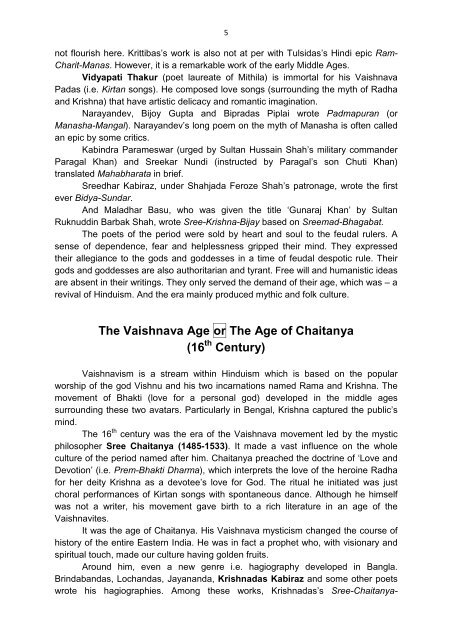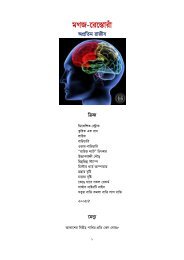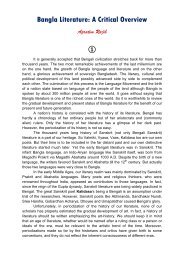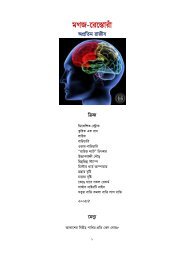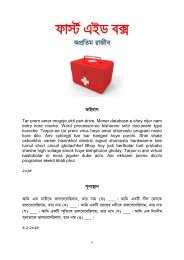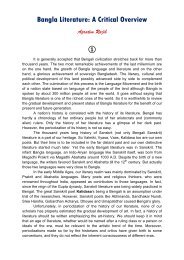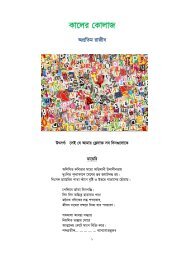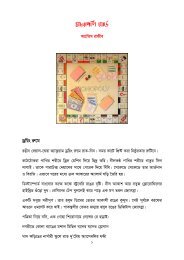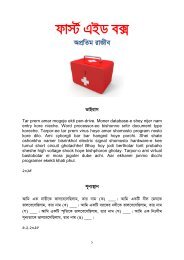BLiterature-Apratim
Create successful ePaper yourself
Turn your PDF publications into a flip-book with our unique Google optimized e-Paper software.
5<br />
not flourish here. Krittibas’s work is also not at per with Tulsidas’s Hindi epic Ram-<br />
Charit-Manas. However, it is a remarkable work of the early Middle Ages.<br />
Vidyapati Thakur (poet laureate of Mithila) is immortal for his Vaishnava<br />
Padas (i.e. Kirtan songs). He composed love songs (surrounding the myth of Radha<br />
and Krishna) that have artistic delicacy and romantic imagination.<br />
Narayandev, Bijoy Gupta and Bipradas Piplai wrote Padmapuran (or<br />
Manasha-Mangal). Narayandev’s long poem on the myth of Manasha is often called<br />
an epic by some critics.<br />
Kabindra Parameswar (urged by Sultan Hussain Shah’s military commander<br />
Paragal Khan) and Sreekar Nundi (instructed by Paragal’s son Chuti Khan)<br />
translated Mahabharata in brief.<br />
Sreedhar Kabiraz, under Shahjada Feroze Shah’s patronage, wrote the first<br />
ever Bidya-Sundar.<br />
And Maladhar Basu, who was given the title ‘Gunaraj Khan’ by Sultan<br />
Ruknuddin Barbak Shah, wrote Sree-Krishna-Bijay based on Sreemad-Bhagabat.<br />
The poets of the period were sold by heart and soul to the feudal rulers. A<br />
sense of dependence, fear and helplessness gripped their mind. They expressed<br />
their allegiance to the gods and goddesses in a time of feudal despotic rule. Their<br />
gods and goddesses are also authoritarian and tyrant. Free will and humanistic ideas<br />
are absent in their writings. They only served the demand of their age, which was – a<br />
revival of Hinduism. And the era mainly produced mythic and folk culture.<br />
The Vaishnava Age or The Age of Chaitanya<br />
(16 th Century)<br />
Vaishnavism is a stream within Hinduism which is based on the popular<br />
worship of the god Vishnu and his two incarnations named Rama and Krishna. The<br />
movement of Bhakti (love for a personal god) developed in the middle ages<br />
surrounding these two avatars. Particularly in Bengal, Krishna captured the public’s<br />
mind.<br />
The 16 th century was the era of the Vaishnava movement led by the mystic<br />
philosopher Sree Chaitanya (1485-1533). It made a vast influence on the whole<br />
culture of the period named after him. Chaitanya preached the doctrine of ‘Love and<br />
Devotion’ (i.e. Prem-Bhakti Dharma), which interprets the love of the heroine Radha<br />
for her deity Krishna as a devotee’s love for God. The ritual he initiated was just<br />
choral performances of Kirtan songs with spontaneous dance. Although he himself<br />
was not a writer, his movement gave birth to a rich literature in an age of the<br />
Vaishnavites.<br />
It was the age of Chaitanya. His Vaishnava mysticism changed the course of<br />
history of the entire Eastern India. He was in fact a prophet who, with visionary and<br />
spiritual touch, made our culture having golden fruits.<br />
Around him, even a new genre i.e. hagiography developed in Bangla.<br />
Brindabandas, Lochandas, Jayananda, Krishnadas Kabiraz and some other poets<br />
wrote his hagiographies. Among these works, Krishnadas’s Sree-Chaitanya-


